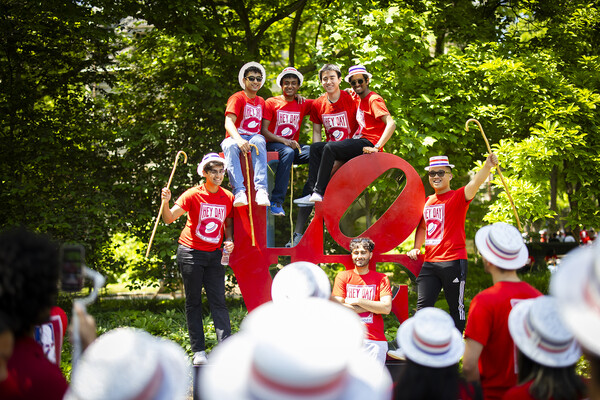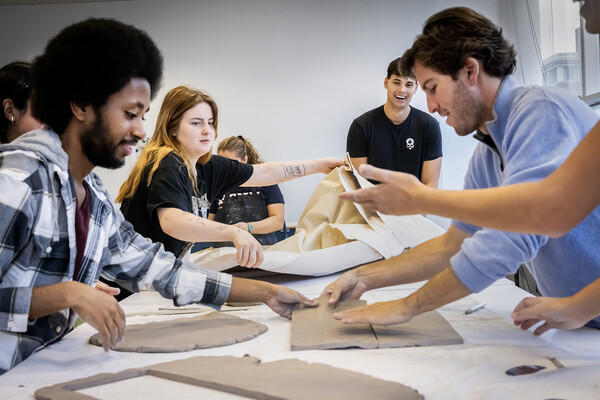
In recent years, the phenomenon of physiological synchrony has captivated behavioral researchers seeking to understand how human brains and bodies align during social interactions.
One compelling example that neuroscientist Michael Platt points to comes from studies of fire-walking rituals in Spain in which many members of a community gather to watch men walk barefoot over hot coals. Researchers looked at the heart rates of the firewalkers, their relatives, and unrelated members during the performance.
“As the heart rates of the firewalker would go up, the heart rates of their spouse or their family member, too, would go up at the same time and go down at the same time,” says Platt, a Penn Integrates Knowledge University Professor, “but the heart rates of unrelated people didn’t sync up this way.”
These findings got Platt and his colleagues thinking: “Could we translate this into an everyday setting? And could we scale it up from a pairwise person-to-person dynamic to a larger group setting, like a business-relevant one where people need to work together to pick the right candidate for a job?”
In a study published in the Proceedings of the National Academy of Sciences, Platt and his colleagues found heart rate synchrony predicted the probability that groups would reach the correct consensus with more than 70% cross-validation accuracy, thus providing a biomarker of interpersonal engagement that facilitates adaptive learning and effective information sharing during collective decision making.
“Heart rate synchrony was a much better predictor than any of the standard kind of survey questionnaire-based self-reports,” Platt says. “It indicates that heart rate synchrony can be a reliable, scalable measure for assessing and improving team dynamics.”
The hidden profile paradigm
For this study, Platt and his team recruited 44 groups of three to six people (204 total) to participate in a decision-making task. Based on the “Hidden Profile Paradigm,” the recruits were required to act as a hiring committee and select the best candidate for a job from a pool of applicants, but the candidates’ information was unevenly distributed among those on the committee. “The task is really hard,” explains Platt, “It’s designed to favor a default option, a specific candidate who might stand out based on some shared knowledge like that they got great grades in college, but there might be hidden critical information that one or a couple of people have.”
This setup ensured that successful decision making depended on effective communication and information sharing within the group.
“In the context of this task,” Platt says, “the ability of teams to critically examine available information and arrive at a decision contrary to the option favored by shared information would be expected to correlate with what we call, ‘high group psychological safety.’”
Platt says that this popular buzzword in the business world really means that a group making decisions together is high functioning because their members are able to speak freely to one another, “to say things that might go against the grain or counter a leader’s opinions, like by saying, ‘We should pick this candidate because I saw they’ve experienced X, which shows me they’ll be able to handle Y.’”
An individual needs to feel safe, confident that they know something the rest of the group doesn’t. This requires some theory of mind, knowing they have some information the rest do not possess, and the ability to say that without fear of being dismissed by the others.
Speaking from the heart
The researchers used heart rate monitors to collect data during the group discussions, focusing on heart rate synchrony as a measure of group cohesion and engagement. “We also made it so that the participants were in a naturalistic environment; they were freely moving in a room and talking as opposed to responding to a questionnaire on a computer screen,” he says.
The heart rate data was analyzed using multidimensional recurrence quantification analysis, a sophisticated method that captures the dynamic interactions of multiple individuals over time.
“Remarkably, when heart rates were more in alignment across any committee, they were more likely to reach the correct consensus and make the best decision,” Platt says. “I’m taken aback by this finding because it’s so simple. Our hearts beat in time with each other, when we have the conditions that are met for using all the information that’s available in a group.”
Platt and his team are looking ahead, interested in exploring the underlying mechanisms that drive heart rate synchrony and its broader implications. Continuous brain and heart readouts could someday allow the use of more sensitive physiological measures, like heart rate variability or neural activity, to better characterize physiological dynamics associated with behaviors that promote group bonding, Platt says. Future research may look into how these physiological markers can be harnessed to improve team performance in various settings, from business to education.
Michael Platt is a Penn Integrates Knowledge Professor and the James S. Riepe University Professor, professor of neuroscience, professor of psychology, and professor of marketing, with appointments in the Perelman School of Medicine, School of Arts & Sciences, and Wharton School at the University of Pennsylvania.
Other authors are Martin Bohlen, K. M Sharika, and Swarag Thaikkandi of the Indian Institute of Technology Kanpur and Nivedita Nivedita of the University of Oxford.
This research was supported by the National Institute of Health (grants R01MH095894, R01MH108627, R37MH109728, R21AG073958, R01MH118203, 866 R56MH122819, and R01NS123054), Wharton Neuroscience Initiative, and Department of Science and Technology, Government of India.






